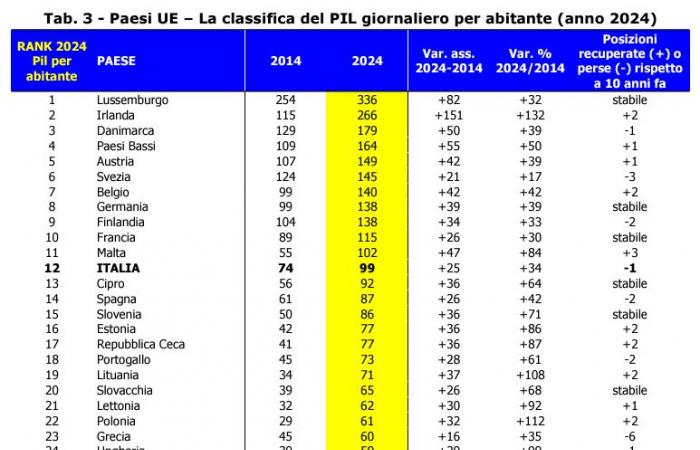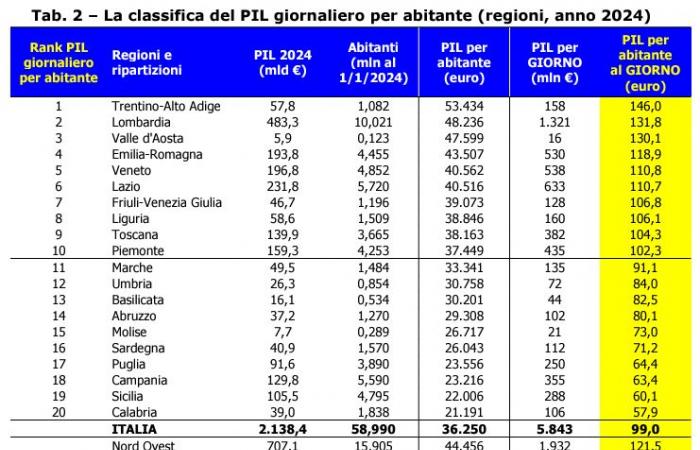This is supported by research from the CGIA of Mestre, underlining that the term “internal” of GDP (Gross Domestic Product) refers to the value generated by both national and foreign companies operating in the country.
Europe and Italy compared on GDP
Everyday, Italy produces 5.8 billion euros of Gross Domestic Product (GDP), a measure obtained by adding the final goods and services produced in a given period of time. This amount is equivalent to 99 euros per day for every Italian citizen, including newborns and centenarians.
The regional differences are very marked: in Trentino-Alto Adige the daily GDP per inhabitant is 146 euros, in Lombardy it is 131.8 euros, in Valle d’Aosta it is 130.1 euros, in Emilia-Romagna it is 118.9 euros and in Veneto it is 110 .8 euros. On the contrary, in Campania the daily GDP per capita is 63.4 euros, in Sicily 60.1 euros and in Calabria 57.9 euros.
The comparison with other European Union countries highlights a significant gap, especially compared to Northern European countries. In Luxembourgthe daily wealth per inhabitant is 336 euros, in Ireland is 266 euros, in Denmark of 179 euros, in Netherlands of 164 euros, in Austria of 149 euros, in Sweden of 145 euros and more Belgium of 140 euros. Among the 27 EU countries, with 99 euros per capita per day, Italy ranks 12th.
No more big businesses
How to interpret the result that emerged from the European comparison reported above? First of all, it should be highlighted that countries with a small population, but with a strong presence of large companies and financial activities, tend to have much higher levels of wealth than others. Furthermore, it is important to note that Italy it no longer has large companies and multinationalsbut has been characterized, for some time now, by a production system made up almost exclusively of micro, small and medium-sized enterprises (SMEs) high work intensity. These companies, on average, show not very high productivity levels and pay lower wages compared to larger companies, thus influencing consumption capacity, e they invest less in research and development compared to large production companies.
The causes of the Italian situation
Over the last 30 years, net of inflation, the average wages of Italians have remained stable, while in most EU countries they have increased. The reasons for this result in Italy include slow economic growth and a low level of labor productivity, especially in the service sector.
Another cause is the absence of large companies, which has negatively influenced the country’s competitiveness compared to its main European competitors. These large companies have disappeared not because of the abundance of small businesses, but because of the inability of large, often public, operators to face the challenges posed by the changes resulting from the fall of the Berlin Wall and Tangentopoli. Until the early 1980s, Italy was a European and world leader in sectors such as chemicals, plastics, rubber, steel, aluminium, IT, automotive and pharmaceuticals. Thanks to the role of public economic bodies and large public and private companies, they were guaranteed employment, research, development, innovation and productive investments.
However, in the last 45 years, Italy it has lost ground and leadership in almost all of these sectorsnot by chance, but due to historical events such as the fall of the Berlin Wall, which reunified Europe and reactivated commercial relations with the countries behind the “Iron Curtain”, pushing many of the large Italian companies out of the market.
Furthermore, Tangentopoli revealed the limitations of many state-owned enterprises that operated in protected markets thanks to political supports. Despite this, over the last 30 years, Italy has remained among the countries economically most advanced in the worldthanks to his SMEs that continue to dominate international markets.
GDP in the Regions
In terms of labor productivity, measured by comparing the added value (GDP net of direct taxes) to the standard work units (AWU), in 2024 the average figure in Italy is equal to 77 thousand euros per AWU, or 210.6 average euros daily.
ULA is a unit of measurement used for quantify the volume of work performed within a company. It is used by ISTAT, and represents the average monthly number of employees employed full-time in the company during a year.
Simply put, a ULA is equivalent to the work performed by an employee on a full-time contract for an entire year. To calculate a company’s total AWU, you need to consider both full-time and part-time workers.
The situation at a territorial level more virtuous you register in Trentino Alto Adige with 253 euros per day for ULA. This region of the Northeast can count on a GDP (or, better, value added) of 52.4 billion euros, on 556 thousand standard work units and on an annual productivity per AWU of 92,595 euros. They follow the Lombardy with 251.4 euros per day per ULA, the Valle d’Aosta with 230.8 euros for ULA and theEmilia Romagna with 226.6 euros per AWU.
The realities where productivity is lower, however, can be seen in the South which, compared to the Centre-North, tends to have an economy less marked by the presence of manufacturing companies and credit/financial/insurance activities. Therefore, the national ranking closes Sardinia with 165.7 euros per day per ULA, the Calabria with 159.5 euros for ULA and the Puglia with 158.2 euros per AWU.

GDP in the Provinces
Still regarding labor productivity, at the provincial level the performance of the metropolitan area stands out Milan which, in 2024, will reach 282.9 euros per day per AWU. The Lombardy capital boasts an added value of 204.4 billion euros, almost 2 million standard work units and an annual productivity per AWU of 103,535 euros. They follow Bolzano with 257.8 euros per day per AWU, Praises with 253.3 euros, Trent with 247.4 euros and Cremona with 246.1 euros. They are at the bottom of the national rankings Benevento And Barletta-Andria-Traniboth with 146.7 euros per ULA, and Ragusa with 138.5 euros.








